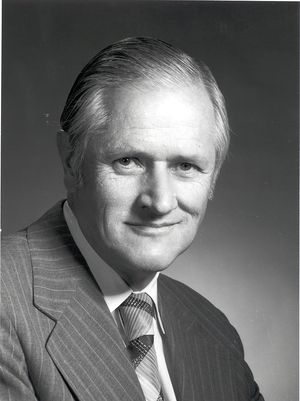James M. Lafferty: Difference between revisions
No edit summary |
m (Text replace - "[[Category:Components, circuits, devices & systems" to "[[Category:Computers and information processing") |
||
| Line 7: | Line 7: | ||
Dr. Lafferty was a [[IEEE Fellow Grade History|fellow of the IEEE]], the American Physical Society and the American Association for the Advancement of Science. He was a member of the American Vacuum Society, serving as its president and secretary and serving on its board. He also served as the president of the International Union for Vacuum Science, Technique and Applications. For his considerable lifetime contributions to the field of electrical engineering, in 1979 Dr. Lafferty was awarded the prestigious [[IEEE Lamme Medal]]. | Dr. Lafferty was a [[IEEE Fellow Grade History|fellow of the IEEE]], the American Physical Society and the American Association for the Advancement of Science. He was a member of the American Vacuum Society, serving as its president and secretary and serving on its board. He also served as the president of the International Union for Vacuum Science, Technique and Applications. For his considerable lifetime contributions to the field of electrical engineering, in 1979 Dr. Lafferty was awarded the prestigious [[IEEE Lamme Medal]]. | ||
[[Category: | [[Category:Computers and information processing|Lafferty]] [[Category:IEEE|Lafferty]] [[Category:Awards & fellow activities|Lafferty]] | ||
Revision as of 15:40, 22 July 2014
Biography
James M. Lafferty was born on April 27, 1916 in Battle Creek, Michigan. He was raised in Kalamazoo and then earned a BS in engineering physics from Western Michigan State University and went on to earn his PhD from the University of Michigan. Thereafter he joined the General Electric Research Laboratories as a research associate. Dr. Lafferty remained at GE for the rest of his career, eventually rising to the position of manager of the Power Electronics Laboratory. He published dozens of technical papers and won more than 60 patents. He was the inventor of the lanthanum boride cathode which was especially useful for demountable electronic systems where high current densities may be required and where the cathode is subjected to high voltage positive ion bombardment. Dr. Lafferty developed the hot cathode ionization gauge, capable of measuring extreme ultrahigh vacua found in outer space. He also dircted the group of GE scientists who made the major technical innovations which made possible the first successful high power vacuum interrupter. This idea led to the development of the vacuum circuit breaker, which had wide use in the US.
Dr. Lafferty was a fellow of the IEEE, the American Physical Society and the American Association for the Advancement of Science. He was a member of the American Vacuum Society, serving as its president and secretary and serving on its board. He also served as the president of the International Union for Vacuum Science, Technique and Applications. For his considerable lifetime contributions to the field of electrical engineering, in 1979 Dr. Lafferty was awarded the prestigious IEEE Lamme Medal.
